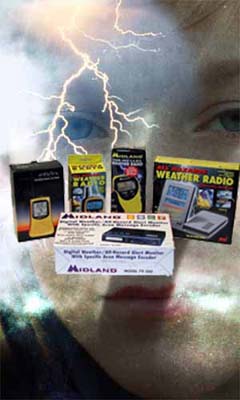| NOAA Magazine || NOAA Home Page |
INDIANA
MANDATES WEATHER ALERT RADIOS IN MANUFACTURED HOUSING
NOAA Weather All Hazards Provides Essential Storm Notification
– Especially At Night
 June
7, 2007 � Officials from NOAA National
Weather Service offices that serve Indiana were on hand today at
the Eastbrook Mobile Home Park in Evansville, Ind., to witness the signing
of C.J.’s Law by Indiana Governor Mitchell Daniels. Named for
two-year-old C.J. Martin, the law mandates installation of NOAA
Weather Radio All Hazards public alert radios in all new and relocated
manufactured housing, within manufactured communities in Indiana, effective
July 1.
June
7, 2007 � Officials from NOAA National
Weather Service offices that serve Indiana were on hand today at
the Eastbrook Mobile Home Park in Evansville, Ind., to witness the signing
of C.J.’s Law by Indiana Governor Mitchell Daniels. Named for
two-year-old C.J. Martin, the law mandates installation of NOAA
Weather Radio All Hazards public alert radios in all new and relocated
manufactured housing, within manufactured communities in Indiana, effective
July 1.
C.J. was one of 20 fatalities caused by the tornado that hit Evansville at 2 a.m., Nov. 6, 2005. The bill was sponsored by Representative Phil Hoy and adopted by the Indiana Legislature following a campaign by C.J.’s mother Kathryn.
“Losing a child has to be the most difficult thing a parent can endure,” said National Weather Service Central Region Director Lynn P. Maximuk. “Kathryn Martin made it her mission to protect other mothers from experiencing her heartbreak. She is to be commended for almost two years of effort and determination that resulted in C.J.’s Law going into effect in Indiana.”
Kathryn Martin and Representative Hoy also will be among those honored by NOAA with a Mark Trail Award on June 21 in Washington D.C., for their work in increasing the awareness and use of NOAA Weather Radio All Hazards in the effort to save lives.
“November 6, 2005, will forever be etched in the minds of Evansville and tri-state residents, but out of such devastation and loss of life that touched so many, one child’s life, C.J.’s, will live on in our hearts as C.J.’s Law lays the foundation to save countless lives in the future,” said Beverly Poole, meteorologist-in-charge of the Paducah Weather Forecast Office, from which a tornado warning was issued for Evansville 13 minutes prior to the twister striking. Still, the tornado proved deadly since many people were sleeping when the storm arrived.
NOAA Weather Radio All Hazards provides immediate broadcasts of severe weather warnings and civil emergency messages — giving those in harm’s way critical lead time to respond and remain safe. Special tones precede the initial broadcast of all emergency announcements regarding immediate weather threats and civil emergency messages to gain a listener’s attention. These tones will also activate radios that are on alert mode, yet silent. This feature is especially crucial when severe storms or other events occur at night when most people are sound asleep.
Broadcasts of tornado warnings, flood warnings, AMBER Alerts for child abductions, chemical spill messages and many other notifications, in addition to routine weather observations and forecasts, make NOAA Weather Radio All Hazards an essential item for every home, business and public area.
NOAA Weather Radio All Hazards, a component of the nation's Emergency Alert System, is comprised of a nationwide network of more than 975 transmitters each directly linked with one of the 123 local offices of NOAA’s National Weather Service, which issues weather warnings and relays civil emergency messages on behalf of law enforcement agencies. NOAA Weather Radio All Hazards is provided as a public service by the National Oceanic and Atmospheric Administration, an agency of the U.S. Department of Commerce.
Relevant Web Sites
NOAA National Weather Service
NOAA Weather Radio All Hazards
Media
Contact:
Chris Vaccaro, NOAA
Office of Communications, (202) 482-0702 or Patrick
Slattery, NOAA Weather Service
Central Region, (816) 268-3135